Luis Muñoz Marín International Airport
| Luis Muñoz Marín International Airport Aeropuerto Internacional Luis Muñoz Marín | |||||||||||||||
|---|---|---|---|---|---|---|---|---|---|---|---|---|---|---|---|
 | |||||||||||||||
.jpg) | |||||||||||||||
| Summary | |||||||||||||||
| Airport type | Public | ||||||||||||||
| Owner | Puerto Rico Ports Authority | ||||||||||||||
| Operator | Aerostar Airport Holdings | ||||||||||||||
| Serves | San Juan, Puerto Rico | ||||||||||||||
| Location | Carolina, Puerto Rico | ||||||||||||||
| Hub for |
Passenger Cargo | ||||||||||||||
| Focus city for | |||||||||||||||
| Elevation AMSL | 9 ft / 3 m | ||||||||||||||
| Coordinates | 18°26′21″N 066°00′07″W / 18.43917°N 66.00194°WCoordinates: 18°26′21″N 066°00′07″W / 18.43917°N 66.00194°W | ||||||||||||||
| Website | http://aeropuertosju.com/en/ | ||||||||||||||
| Map | |||||||||||||||
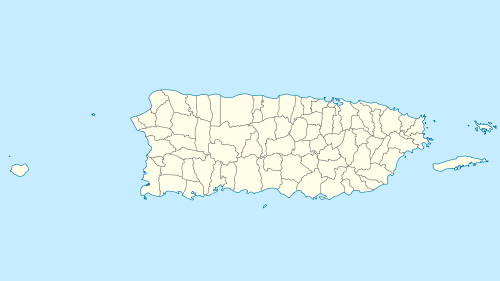 SJU Location in Puerto Rico | |||||||||||||||
| Runways | |||||||||||||||
| |||||||||||||||
| Statistics (2017) | |||||||||||||||
| |||||||||||||||
Luis Muñoz Marín International Airport (IATA: SJU, ICAO: TJSJ, FAA LID: SJU) (Spanish: Aeropuerto Internacional Luis Muñoz Marín, Or Isla Verde International Airport/Aeropuerto Internacional de Isla Verde) is a joint civil-military international airport named for Puerto Rico's first democratically elected governor and located in suburban Carolina, Puerto Rico, three miles (five kilometres) southeast of San Juan. It is the busiest airport in the Caribbean region by passenger traffic. Over 4 million passengers board a plane at the airport per year according to the Federal Aviation Administration.[5]
The airport is owned by the Puerto Rico Ports Authority and managed by Aerostar Airport Holdings, a public–private partnership which was awarded a lease by the government of Puerto Rico to operate and manage the airport for 40 years beginning in 2013.[6] SJU is the second international airport to be privatized in the United States and its territories, and, as of 2013, is the only currently privatized airport in the nation.[7] Taxis and rental cars can transport travelers to and from the airport. The airport serves as a gateway to the Caribbean islands. SJU covers 1,600 acres (647 ha) of land.[1]
History
In 1945, aware of the importance of aviation for the development of the economy of Puerto Rico, the island government had pointed out the need to build a newer international airport capable of handling the growing air traffic of San Juan International Airport, in Isla Grande, that had been operating since 1929; as well as responding to the needs of the future. Until then Isla Grande had been the main airport of Puerto Rico. As airlines began switching from propeller aircraft to jets, the 4,000-foot Isla Grande airstrip did not have the necessary distance for modern aircraft to land and take off. (The Isla Grande Airport, now named in honor of Maj. Fernando Luis Ribas Dominicci, Pilot of the US Air Force F-111, who was killed-in-action in Libya in 1986, currently has a runway of 5,542 feet in length.)
On the other hand, the government had also decided that it should direct the air operations, relying these powers in the Puerto Rico Transportation Authority, created in 1942, which later became the Ports Authority. The Committee of Airports of the Planning Board began to study the feasibility of the new airport, submitting in 1944 its plans and studies to the Federal Civil Aeronautics Administration, to determine the most appropriate place.
In 1945, it was determined that the place would be Isla Verde (Carolina), to make the airport a metropolitan facility. Construction was approved by the Puerto Rico Planning Board in 1946, and the project began in 1947. During that same year, the Port Authority of Puerto Rico assumed title to and ownership of the Isla Grande Airport and other regional airports, which had been military installations during World War II.
The design of the new airport was carried out by the firm of Toro-Ferrer, founded by the architects Miguel Ferrer (1914–2004), and architect Osvaldo Toro (1914–1995), which were also known for their designs of the Caribe Hilton Hotel and the Supreme Court of Puerto Rico.
During 1949, the first phase of construction of the Isla Verde Airport was completed: cleaning, filling, leveling and drainage of soils. The second phase also began: paving the runway, taxiways, and platforms.
The certified airlines operating in Puerto Rico in 1950 were Pan American World Airways, Eastern Air Lines, Riddle Aviation Co., Caribbean Atlantic Airlines, British Airways, Iberia, Dominican Airlines and Flying Tigers Airline. The latter contracted the movement of migrant workers to the United States, with the Insular Department of Labor, transferring some 5,706 workers to different points of that nation, at a cost of $55 per passage.
On May 22, 1955, the Puerto Rico International Airport was inaugurated, built on a 1,718.72 acre land lot. The facilities, estimated at a cost of $22 million, had a six-story passenger terminal, control tower, 7,800-foot long runway (8–26), cargo building, fire and police stations, and a hotel.
Hundreds of people, enthusiastic about the new aerial installation, witnessed the inaugural events presided over by Luis Muñoz Marín. In a part of his eloquent speech, the Governor said: "Impressive is this work in its structure and in its many facilities, but not as impressive as the fact that this center of communications symbolizes the great technical processes that are transforming civilization".
The first year of operations of the new airport produced an upward movement of passengers to 694,199 and a total of 28 million pounds of cargo was handled.
Evolution of the airport
By 1959, major airlines had introduced jets, which significantly reduced flight time and increased flight cruising safety. At the start of operations, the airport had only one runway (8/26), the old control tower on top of the Hotel, 3 terminals and a parking lot for 200 cars.
During the beginning of the 60s, several expansion and improvement projects began, starting with the runway extending from 7,800 to 10,000 feet in length. Construction of the second runway (10–28) on the south side began in May 1967. The project was completed in 1974 at an approximate cost of $4.2 million. With the introduction of the 747 aircraft, runway 8–26 was reinforced and widened in 1974, and ten years later it was repaved.
On January 17, 1983, the two-leveled vehicular access system was built at a cost of approximately $9.2 million. This access separates the arrivals and departures of passengers at different levels, to eliminate traffic congestion.
On February 18, 1985, the Governor of Puerto Rico, Rafael Hernández Colón, converted to law the project to Senate Number 1, officially designating the international airport under the name of Luis Muñoz Marín, in honor of the first governor of Puerto Rico elected by the people.
The airport served as a hub for Pan Am, Trans Caribbean Airways, Eastern Air Lines, and for a short period a focus city for TWA. It was also the center for Puerto Rico's international airline, Prinair, from 1966 to 1984, when Prinair went bankrupt. In 1986, American Airlines together with American Eagle established a center in Puerto Rico to compete with Eastern Air Lines.
In the past, the airport has been served by Mexicana de Aviación, Lufthansa, Air France, KLM, Martinair, British Airways, British Caledonian, Virgin Atlantic, Norwegian Air Shuttle, Air Europa, ACES Colombia, BWIA West Indies Airways, ALM Antillean Airlines, Air Jamaica, Viasa, Aeropostal, Volaris, LACSA, Aerolíneas Argentinas, Dominicana De Aviación, Wardair, ATA Airlines, Northwest Airlines, Continental Airlines, AirTran Airways, and US Airways.
With the expansion of Eastern Airlines and American Airlines facilities, turning Puerto Rico into their Caribbean hub, the historic figure of eight million passengers at the end of 1988. That same year, an investment in expansion and remodeling of $137 million was announced.
The 1990s marked the beginning of important projects to modernize and expand the facilities and services of the airport in response to the boom in passenger and cargo movement and growth projections.
In the period from 1990 to 2000, several infrastructure works were carried out with an investment of approximately $128 million. Some of these include the expansion of the two-level access road to a maximum of 10 lanes on both levels, the new air traffic control tower (designed by Segundo Cardona FAIA of SCF Architects[8]), a parallel taxiway connecting lanes 8 and 10, a parking garage, and the first and second phase of the Terminal B expansion, modification, and rehabilitation project.
In subsequent years, from 2000 to 2005, other major projects were initiated and completed such as the third phase of the rehabilitation, modification and expansion of Terminal B and the new B / C connector at a cost of $35.9 million, the construction of a new building for the Air Rescue unit at a cost of $4.1 million, and remodeling the hotel at a cost of $5 million.
In 2008 the airport has been receiving major upgrades, including a new terminal (Terminal A), pavement and expansions, new light systems, press conference rooms, and new fast food restaurants along its corridors. In 2012, the new Terminal A was opened, which is currently occupied by JetBlue Airways.[9]
The Airport is owned by the Ports Authority but since 2013 it is managed by Aerostar Airport Holdings, in a private public initiative through which a contract was granted to that company to operate the airport for 40 years.
Operations

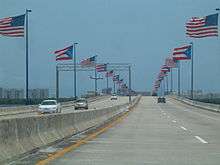
Luis Muñoz Marín International Airport is Puerto Rico's main international gateway and its main connection to the United States. Domestic flights fly between Carolina and other local destinations, including Culebra, Mayagüez and Vieques. The airport is accessed from the San Juan district of Hato Rey, the island's financial district, via the Teodoro Moscoso Bridge. Old San Juan is accessed via the Baldorioty de Castro Expressway (PR-26). The airport serves as the Caribbean hub for Cape Air, Air Sunshine, and Seaborne Airlines, as well as a focus city for JetBlue Airways.[10] JetBlue is the largest carrier in San Juan, with 51 daily flights on an average day.
Terminals
Luis Muñoz Marín Airport has one main terminal building with four concourses and a separate terminal with one concourse. However, all terminals are connected.
Terminal A
In June 2012, Terminal A was opened and occupied solely by Jetblue Airways, making San Juan a focus city. When Terminal B was closed for renovations, four regional airlines were moved to Terminal A.
Terminal B (Concourse)
Terminal B reopened after a $130 million renovation in December 2014, with Delta, United, Southwest, and Spirit as its tenants (with all operations moved in by February 2015).[11]
Terminal C (Concourse)
Terminal C reopened from its $55 million renovation on March 2016.[12] The letter designation for Terminal C was discontinued, and the concourse was instead added as an extension to Terminal B.[13] The Terminal B extension was later changed back to Terminal C.[14]
Both Terminals B and C feature high-end retail stores and new restaurants, improved seating as well as automated baggage scanners currently used only by six other airports in the mainland U.S.
An Avianca VIP airport lounge[15] is located at the entrance of Terminal C. This All Inclusive lounge is operated by Global Lounge Network.[16]
Terminal D (Concourse); closed
Terminal D is currently undergoing renovations. It was previously occupied by American Airlines and other OneWorld airlines until the departure of the OneWorld airlines in March 2013.
Terminal E (Concourse); closed
Terminal E is currently unused and undergoing renovations. It was previously occupied by American Airlines and its regional affiliate, Executive Airlines, which operated flights under the American Eagle brand. The area became unused after American Airlines moved their flights to Terminal C in 2015. The American Eagle flights were moved to Terminal D before being discontinued in 2013.
Airlines and destinations
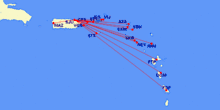
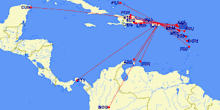
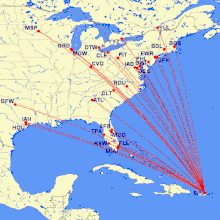
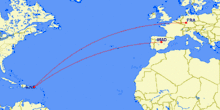
Passenger
Charters
| Airlines | Destinations |
|---|---|
| Air Sunshine | Anguilla, Dominica–Melville Hall, Nevis, Sint Maarten, Tortola, Virgin Gorda, Antigua, St. Lucia, St. Vincent, Grenada, Trinidad, Dominican Republic, Turks and Caicos, Aruba, Curaçao, Barbados |
| Bahamasair | Nassau |
| Fly BVI Ltd – Caribbean Air Charter | Anegada, Tortola, Virgin Gorda, Dominica–Canefield |
| Island Birds | Seasonal: Anguilla, Dominica–Melville Hall, Nevis, Sint Maarten, Tortola, Virgin Gorda, Antigua, St. Lucia, St. Vincent, Grenada, Trinidad, Dominican Republic, Turks and Caicos, Aruba, Curaçao, Barbados, Dominica–Canefield |
| Miami Air | Seasonal: Punta Cana |
| Rainbow International Airlines | Anguilla |
| Songbird Airways | Seasonal: Punta Cana |
| Swift Air | Seasonal: Cancún, Punta Cana |
| Tradewind Aviation | Dominica-Canefield |
| World Atlantic Airlines | Seasonal: Miami, Orlando, Punta Cana |
| VI Airlink | Seasonal: Beef Island |
| Xtra Airways | Seasonal: Cancún, Punta Cana |
Cargo
Statistics
Traffic statistics
| Year | Total passengers | % Change |
|---|---|---|
| 2001 | 9,453,564 | – |
| 2002 | 9,389,232 | |
| 2003 | 9,716,687 | |
| 2004 | 10,568,986 | |
| 2005 | 10,768,698 | |
| 2006 | 10,506,118 | |
| 2007 | 10,409,464 | |
| 2008 | 9,378,924 | |
| 2009 | 8,245,895 | |
| 2010 | 8,491,257 | |
| 2011 | 7,993,381 | |
| 2012 | 8,448,172 | |
| 2013 | 8,347,119 | |
| 2014 | 8,569,622 | |
| 2015 | 8,733,161 | |
| 2016 | 9,037,134 | |
| 2017 | 8,407,404 |
| Rank | Airline | Passengers | Share |
|---|---|---|---|
| 1 | JetBlue Airways | 2,090,000 | 30.90% |
| 2 | American Airlines | 1,464,000 | 21.65% |
| 3 | Southwest Airlines | 1,135,000 | 16.78% |
| 4 | Delta Air Lines | 714,000 | 10.56% |
| 5 | United Airlines | 580,000 | 8.57% |
Top destinations
| Rank | City | Passengers | Carriers |
|---|---|---|---|
| 1 | 573,530 | JetBlue, Southwest, Spirit, Frontier | |
| 2 | 443,850 | American, Delta, JetBlue | |
| 3 | 385,680 | JetBlue, Southwest, Spirit | |
| 4 | 308,400 | American | |
| 5 | 222,900 | Delta | |
| 6 | 199,430 | JetBlue, Southwest, United | |
| 7 | 195,940 | American, Frontier | |
| 8 | 125,740 | American | |
| 9 | 124,010 | JetBlue, Southwest | |
| 10 | 111,170 | American, United |
| Rank | Airport | Passengers | Carriers |
|---|---|---|---|
| 1 | 238,931 | JetBlue, PAWA Dominicana | |
| 2 | 77,564 | JetBlue, Seaborne, charter airlines (27,764) | |
| 3 | 69,871 | Copa | |
| 4 | 47,940 | Air Sunshine, Cape Air, Seaborne | |
| 5 | 30,636 | JetBlue, Seaborne | |
| 6 | 26,481 | JetBlue, Seaborne | |
| 7 | 21,812 | Avianca | |
| 8 | 21,019 | Iberia, Air Europa | |
| 9 | 14,358 | Air Canada, WestJet | |
| 10 | 11,157 | Condor |
Military

Accidents and incidents
- On March 5, 1969, Prinair Flight 277, a de Havilland Heron from St. Thomas, United States Virgin Islands, was attempting to land at the airport when it crashed into mountainous terrain near Luquillo, killing all 19 on board. An NTSB investigation found that an air traffic controller at the airport mistakenly thought the aircraft was near San Juan when it actually was near Fajardo instead.[27]
- On December 31, 1972, baseball star Roberto Clemente and his companions died when their DC-7 crashed soon after takeoff from Isla Verde during a relief flight bound for Nicaragua. Neither the bodies of the victims nor the plane's wreckage was ever found.[28]
- On June 27, 1985, an American Airlines DC-10-10 registered N129AA operating Flight 633 to Dallas/Fort Worth International Airport with 257 passengers on board aborted take-off from runway 8 after a loud rumbling sound was heard by the crew as the airplane approached V1. Unable to stop the aircraft on the runway, the aircraft ended up nose-first in the lagoon at the end of the runway. A nose gear tire blowout was suspected. There were no fatalities, and aircraft returned to service six months later.[29]
- On July 29, 1986, a Borinquen Air Douglas C-53D registered N27PR crashed into a lagoon on approach. The aircraft was on a cargo flight to Golden Rock Airport, Saint Kitts and Nevis, when the starboard engine failed shortly after take-off and the crew decided to return to Carolina. One of the two crew members was killed,[30] the other was seriously injured.[31]
- On March 1, 1989, a Borinquen Air Douglas C-49J registered N28PR ditched on approach following a failure of the port engine.[32] Although the landing gear was retracted, the crew did not feather the propeller. This resulted in increased drag which made flight impossible.[33] The aircraft was on an international cargo flight from Golden Rock Airport, Saint Kitts and Nevis.[32]
- On September 17, 1989, a Tol Air Services Douglas C-47A registered N100DW was damaged beyond economic repair by Hurricane Hugo.[34]
- On May 11, 1997, a British Airways DC-10-30, G-NIUK, operated by Flying Colours Airlines, Flight 4508 (BA4508), operating as a Title 14 CFR Part 129, scheduled flight to Gatwick Airport, was evacuated via the slides after the No. 3 (right) engine caught fire at the San Juan International Airport. Visual meteorological conditions prevailed and an IFR flight plan was filed. The airplane was not damaged. The flightcrew of 3, cabin crew of 11, and 248 passengers were not injured. One passenger was seriously injured during the evacuation.[35]
- On July 9, 1998, an American Airlines Airbus A300B4-605R registered N80057 operating flight 574 had a fire in the No. 1 engine shortly after takeoff from Luis Munoz Marin International Airport. The airplane sustained minor damage. The captain, first officer, 7 flight attendants, and 215 passengers were not injured. Twenty-eight passengers reported minor injuries during the post-landing emergency evacuation.[36]
- On September 24, 1998, a Trans-Florida Airlines Convair 240-13 registered N91237 had an engine problem on take-off. It attempted to return to the airport, but lost altitude and was forced to land in a salt water lagoon some 2 miles (3.2 km) short of the runway. Though the aircraft was written off, the two crew and one passenger were uninjured.[37]
- On April 4, 2001, a Roblex Aviation Douglas DC-3A registered N19BA ditched in the ocean after suffering a double engine failure while on a local training flight. Both crew members escaped. The aircraft sustained minor damage.[38][39]
- On May 9, 2004, an American Eagle ATR 72 operating flight 5401 crashed in San Juan, Puerto Rico after the captain lost control of the aircraft while landing. Seventeen people were injured, but there were no fatalities.[40]
- On March 15, 2012, a Jet One Express cargo Convair 440 operating a flight to St. Maarten crashed near the airport, killing its two occupants. The plane went down in a lagoon after the pilot reported engine trouble.[41][42]
- On December 2, 2013, an IBC Airways Swearingen SA227-AC Metro III registered N831BC crashed into a terrain near La Alianza, Arecibo, Puerto Rico. The aircraft was on a cargo flight from Santo Domingo, Dominican Republic, when the crew lost control of the aircraft for reasons that could not be determined. Both crew members were killed.[43]
- On August 9, 2014, a JetBlue Airbus A321 operating flight 704 to JFK International Airport, New York had to abort takeoff after one of the engines caught fire. All 186 passengers were evacuated from the aircraft. Two women were slightly hurt during evacuation.[44]
- On June 3, 2017, a fatal crash happened at nearby Pinones Beach when an Air America Airlines airplane, on its way from San Juan to Culebra, tried to perform an emergency landing at the airport, going into the beach's waters instead. A 15-year-old female died, while a 14-year-old female, a 45-year-old male passenger and the aircraft's male pilot were rescued injured but alive.[45]
In popular culture
- The airport is featured in Hunter S. Thompson's novel The Rum Diary.
- In the 1984 movie Conexión Caribe, music group Los Chicos arrived at the Luis Muñoz Marín International Airport and boarded an Oceanair airplane.
- Music group Menudo recorded a music video for their song "Claridad", in 1981 at the nearby Isla Verde Beach in Piñones. A Lockheed L-1011 aircraft is seen landing at Luis Muñoz Marín International Airport in the video.
- The airport is seen in several scenes of action film Illegal Tender, where a Puerto Rican youngster flies to the Island from the United States several times.
See also
References
- 1 2 FAA Airport Master Record for SJU (Form 5010 PDF), effective March 15, 2007
- ↑ "Air Traffic Activity System (ATADS)". Federal Aviation Administration. Retrieved June 6, 2015.
- ↑ Airport information for Luis Muñoz Marín International Airport at Great Circle Mapper.
- ↑ "Luis Muñoz Marín International Airport". Google Maps. Google. Retrieved 9 June 2018.
- ↑ CY 2010 Passenger Boarding Archived February 2, 2015, at the Wayback Machine.
- ↑ "Puerto Ricans protest deal with Mexican firm to run airport". EFE. February 13, 2013. Archived from the original on March 1, 2013. Retrieved February 25, 2013.
- ↑ Sechler, Bob (February 26, 2013). "Puerto Rico Airport to Go Private". The Wall Street Journal. Retrieved February 27, 2013.
- ↑ Cardona, Segundo; Hermida, Teresa, eds. (2008). Segundo Cardona (in English and Spanish). Guaynabo, PR: DASE. ISBN 9780615154022.
- ↑ "JetBlue | Help". Help.jetblue.com. Retrieved April 29, 2013.
- ↑ "JetBlue | Investor relations | Press Releases". Investor.jetblue.com. Archived from the original on January 26, 2013. Retrieved April 29, 2013.
- ↑ "New Airport Terminal Opens in San Juan". Caribbean Journal. December 18, 2014. Retrieved January 22, 2015.
- ↑ "LMM Airport officials unveil new $55M Terminal C". News Is My Business. March 18, 2016. Retrieved March 25, 2016.
- ↑ https://www.facebook.com/AeropuertoSJU/photos/a.738839869566070.1073741828.189594561157273/990420577741330/?type=3&theater
- ↑ http://aeropuertosju.com/mapas/
- ↑ https://www.facebook.com/notes/avianca/avianca-inaugura-nueva-sala-vip-en-el-aeropuerto-internacional-luis-mu%C3%B1oz-mar%C3%ADn-/10152592943581822/
- ↑ http://www.globalloungenetwork.com/
- ↑ https://www.usatoday.com/story/travel/flights/todayinthesky/2018/10/09/jetblue-airways-new-flights-boston-rochester-fort-lauderdale-ecuador-phoenix-exits-dulles/1577173002/
- ↑ https://www.usatoday.com/story/travel/flights/todayinthesky/2018/10/09/jetblue-airways-new-flights-boston-rochester-fort-lauderdale-ecuador-phoenix-exits-dulles/1577173002/
- ↑ Passenger Movement LMM International Airport 2001–2006 Puerto Rico Ports Authority
- ↑ Passenger Movement LMM International Airport 2002–2007 Puerto Rico Ports Authority
- ↑ Passenger Movement LMM International Airport 2008–2009 Puerto Rico Ports Authority
- ↑ Passenger Movement LMM International Airport Jul 2009 – Jun 2011 Puerto Rico Ports Authority
- ↑ Carga y pasajeros aéreos y marítimos Instituto de Estadísticas de Puerto Rico
- ↑ Información Financiera Aeropuertos del Sureste
- 1 2 https://www.transtats.bts.gov/airports.asp?pn=1&Airport=SJU&carrier=FACTS
- ↑ "Air Carriers : T-100 Segment (All Carriers)". 2015.
- ↑ Ranter, Harro. "ASN Aircraft accident de Havilland DH-114 Heron 2D N563PR San Juan". aviation-safety.net. Retrieved 2016-05-04.
- ↑ http://bleacherreport.com/articles/1149087-21-facts-you-may-not-know-about-roberto-clemente-on-the-anniversary-of-his-debut
- ↑ NTSB/AAR-86/01/SUM
- ↑ "N27PR Accident description". Aviation Safety Network. Retrieved July 27, 2010.
- ↑ "NTSB Identification: MIA86MA217". National Transportation Safety Board. Retrieved July 27, 2010.
- 1 2 "N28PR Accident description". Aviation Safety Network. Retrieved July 27, 2010.
- ↑ "NTSB Identification: MIA89FA096". National Transportation Safety Board. Retrieved July 27, 2010.
- ↑ "N100DW Hull-loss description". Aviation Safety Network. Archived from the original on November 2, 2012. Retrieved July 27, 2010.
- ↑ "Engine fire, McDonnell Douglas DC-10-30, G-NIUK, May 11, 1997". fss.aero. 1997-05-11. Retrieved March 9, 2017.
- ↑ "American Airlines flight 574, In-flight Fire, San Juan, Puerto Rico, July 9, 1998". www.ntsb.gov. Retrieved 2016-05-04.
- ↑ Aviation Safety Network Retrieved November 27, 2006
- ↑ "N19BA Accident description". Aviation Safety Network. Retrieved June 21, 2010.
- ↑ "MIA01IA110". National Transportation Safety Board. Retrieved June 21, 2010.
- ↑ "Crash During Landing, Executive Airlines Flight 5401, Avions de Transport Regional 72–212, N438AT, San Juan, Puerto Rico, May 9, 2004" (PDF). Retrieved April 23, 2013.
- ↑ "The Aviation Herald". Retrieved June 6, 2015.
- ↑ "Cargo plane crashes in Puerto Rico with 3 on board". Archived from the original on May 1, 2012.
- ↑ https://aviation-safety.net/database/record.php?id=20131202-0
- ↑ "De alta pasajeras heridas en accidente con de avión de JetBlue". El Nuevo Dia. 2014-08-10. Retrieved 2016-05-04.
- ↑ http://www.primerahora.com/noticias/policia-tribunales/nota/fallecemenorydospersonasresultanconquemadurasenchoquedeavioneta-1228178/
External links

- OpenStreetMap - Luis Muñoz Marín International Airport
- SkyVector - Luis Munoz Marin International Airport
- Official website
- FAA Airport Diagram (PDF), effective October 11, 2018
- Resources for this airport:
- FAA airport information for SJU
- AirNav airport information for TJSJ
- ASN accident history for SJU
- FlightAware airport information and live flight tracker
- NOAA/NWS latest weather observations for TJSJ
- SkyVector aeronautical chart for SJU